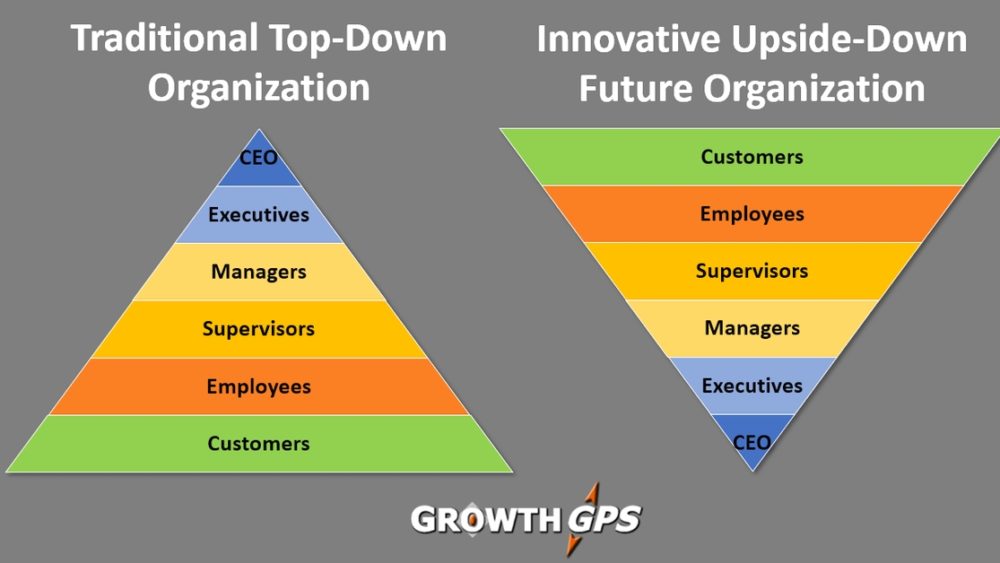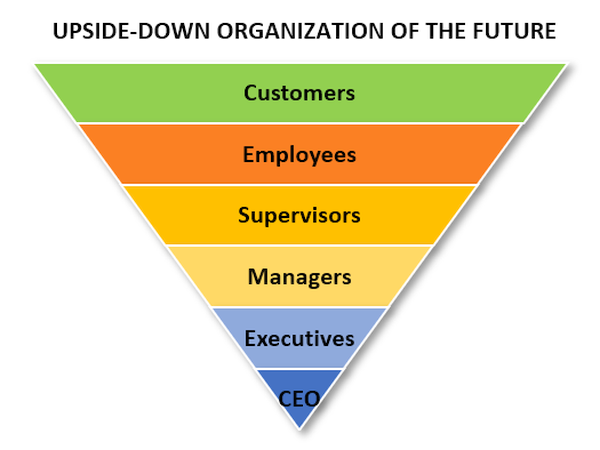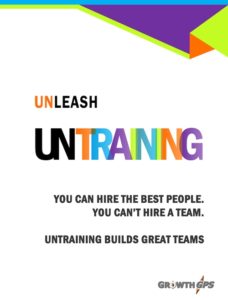Communications Conundrum… solved!
In the traditional top-down organization, customers are kept at a great distance from executives who make decisions. The best customer knowledge is held by employees at the bottom, who are told what to do and how to do it by managers and supervisors compelled to follow directions from decision-makers at the top. Rarely does anyone ask employees with direct customer contact for feedback because the primary flow of information is top-down.
Is it any wonder Communications is today’s common roadblock to business performance? With many layers buffering decision-makers at the top from the customers, not only do meaningful communications get lost but it’s no wonder employees with direct customer contact wonder why they’re told to do the opposite of what makes sense.
By turning the organization upside-down, the true customer-focused organization emerges. The flow of information remains top-down, but now customer information drives decision-making. The upside-down organization responds quickly to changes in customer needs because supervisors, managers and executives are challenged to support those above them driven most by customer needs.
Customer-driven? Enhancing the customer experience (CX)? How can it be that we talk all things customer, yet traditional top-down organizations dominate most industries and companies, from startups to the largest global corporations?
View from the top of Top-Down Organizations
Executives in all industries and sizes of companies bemoan ills about their organizations often, including –
- “Change takes too long around here” – and 70% of change initiatives fail… (Forbes)
- “Employees aren’t dedicated” – 85% of employees are NOT engaged… (Gallup)
- “Employees don’t trust us” – only 32% trust their employers… (Edelman Trust Barometer)
- “We’re fast to decide and slow to act” – 57 days between decisions at the top and action… (Gartner HR)
- “Employees lack confidence in where the company is headed” – 78% leave due to lack of confidence… (Gallup)
- “Employees hear different priorities from different managers” – 57% of employees leave because of the manager… (DDI Frontline Leader Project)
- “Communication stinks around here” – 91% of employees indicate leaders lack communication skills… (Interact/Harris)
Are those woes and statistics any wonder when employees aren’t empowered to do what’s right for the customer? Too often people at the top of traditional hierarchy-type organizations see themselves as superior to those lower in the hierarchy. Power resides at the top and so does decision-making most of the time.
Conclusion: Great customer experience can only be achieved with great employee experience! Great employee experience requires a different organization – turning the hierarchy upside-down.
The Upside-Down Organization
In the Upside-Down Organization, the customers as well as employees who interact with them regularly are at the top. This emphasizes customer focus, and values the knowledge about the customer held by employees.
The role of supervisors is to support employees with the resources to do what’s best for the customer. Ultimately, the same holds true for the managers, executives and the ceo.
The upside-down organization makes clear that management “works for” or in support of the employees who serve the customers. In fact, the upside-down organization only works as intended when employees are empowered to act on behalf of the customer, and management supports employee needs with processes and resources in a collaborative manner.
View from the top of Upside-Down Organizations
When we facilitate projects that simulate Upside-down organizations, leading bottom-up innovation, we discover the view from the top is exactly opposite the top-down organization –
- Employees are highly engaged to creatively solve each customer’s unique problem
- Employees trust supervisors to deliver resources needed to meet customer promises
- Speed of action is fast, equaling the speed of employee decision-making
- Employees know the company is headed in the right direction from positive customer feedback
- Employees hear the same priority from every manager – “do what’s best for the customer”
- Communication is powerful, celebrating customer praise from top to bottom.
Engagement Puzzle… solved!
Roles in the Upside-Down Organization
Employees – enjoy the challenge to best serve each customer as brand advocates and relationship builders
Supervisors – enjoy the challenge to innovate products/services based on collective employee actions
Managers – enjoy collaborating to prioritize innovations and allocate resources to fast-track the best ones
Executives – enjoy fostering the collaborative culture and promoting the continuous stream of new products/services
These roles are radically different from those in the top-down organization! Instead of developing and/or being driven by controls and processes, everyone top to bottom is challenged, learning, collaborating and supporting each other. Decisions are made by everyone. Information flows in both directions.
Innovation Challenge… solved!
Business Outcomes of the Upside-Down Organization
- Innovation permeates at fast speeds
- High employee engagement
- High levels of trust top to bottom built on serving the customer
- Collaborative culture inspires information sharing and open communication
- Innovative career development paths emerge as silos break down
- Resources are allocated based on meeting immediate customer needs
- Increased productivity
- Increased employee retention
- High employee net promoter score (NPS) – they readily brag up the company
- High customer NPS – they tell friends about their experience
- Improved profitability
These outcomes are consistent with Gallup research that indicates organizations with high employee engagement achieve:
- 65% higher Employee retention
- 52% faster Innovation
- 41% better Quality
- 28% higher Customer satisfaction
- 21% stronger Productivity
- 22% better Profitability
Launch Your Journey
Building the Upside-down organization doesn’t happen overnight. It’s not changing the org chart or job descriptions. It’s a journey. That journey begins with small steps, like practicing anything new – a new sport or a new technique – building confidence that allows taking bigger steps.
Our team at Growth GPS can support your journey’s launch and evolution –
- Our ASSESSMENTS help you understand the current state and track progress
- Our exclusive MAD TEAMS FRAMEWORK provides the early small steps
- Our innovative LEADERSHIP DEVELOPMENT TRAINING supports everyone with new skills
- Our project management assures we stay on track and course correct when needed




